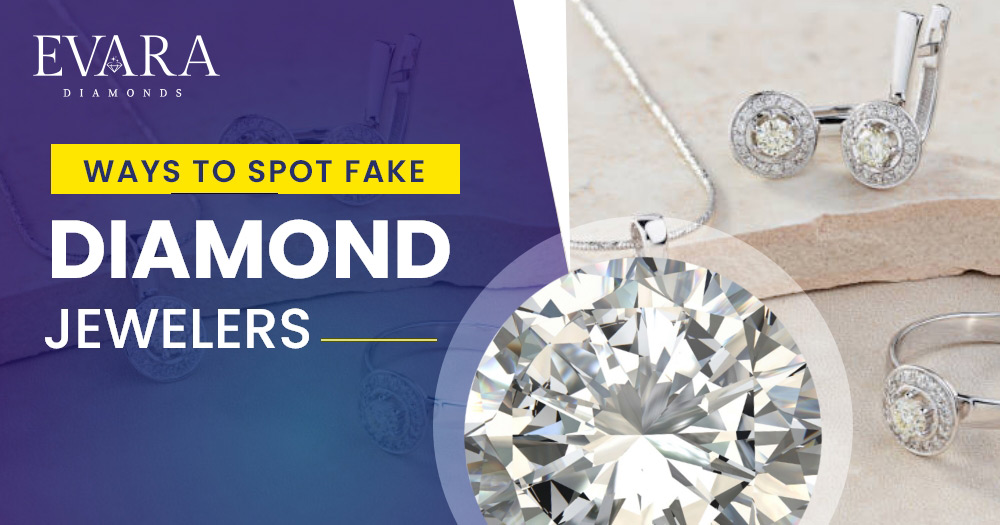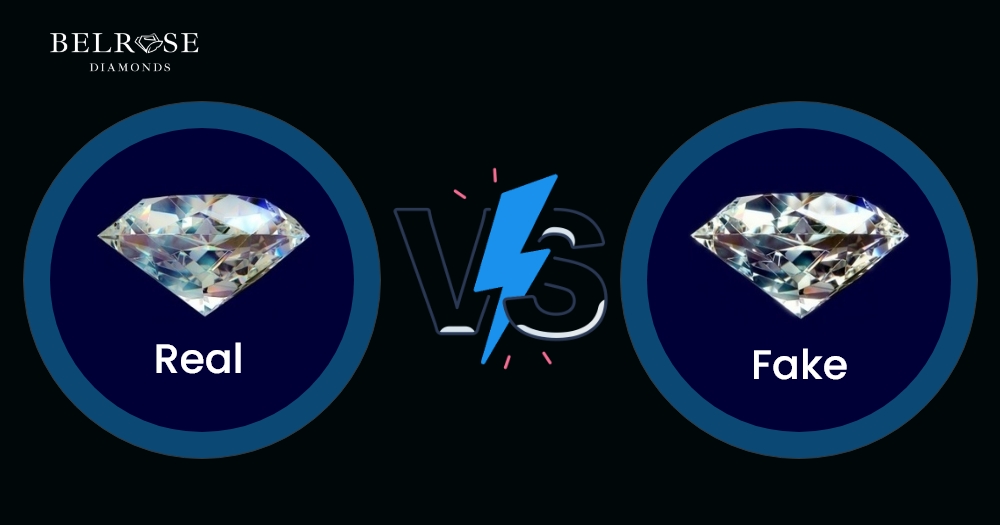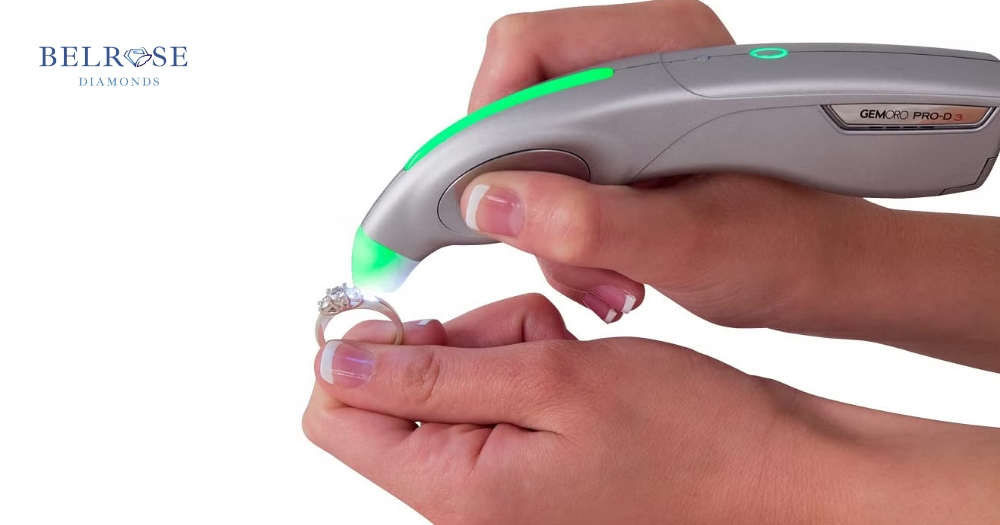10 Ways to Spot Fake Diamond Jewelry

Its crucial to have the expertise to differentiate the genuine from the fake ones. While imitation diamonds can be as deceptive as authentic ones, it’s not worth the expense if you’re paying for something that lacks the real charm. In this illuminating guide, we will explore ten ways to identify fake diamond jewelry and expose the counterfeits. Armed with these strategies, you’ll be able to purchase diamond jewelry with confidence. In this guide, we will explore the ways to spot fake diamonds.
What are the Different Kinds of Fake Diamonds?
There are many materials competing for the most realistic copy in the convoluted world of fake diamonds. There are countless alternatives, including rhinestones and cubic zirconia. Even while these artificial materials can resemble actual diamonds, they don’t have the same elemental makeup as carbon. As a result, they lack the true diamond’s strength and purity.
1. Cubic Zirconia
Cubic Zirconia (CZ), one of the most common fake diamond materials, is made from zirconium oxide (zircon) and can mimic the look and shine of a real diamond. Cubic Zirconium come in various colors and shapes, with the quality determined by the cut and polish. High-quality CZs can be difficult to distinguish from the real thing.
2. Moissanite
While this stone looks very much like a diamond and even has a similar sparkle, it’s actually composed of silicon carbide rather than carbon. Moissanite is also much softer than diamonds and can be scratched easily. Additionally, moissanite will also display double refraction when examined under magnification – something that diamonds don’t do.
3. Glass
Glass jewels can also be faceted to resemble real diamonds and come in a range of colors. However, glass cannot match the same brilliance as a real diamond.
4. Crystals
Crystal is often made with lead glass and can have a diamond-like sparkle. However, it too lacks the same level of clarity and brilliance as a real diamond.
5. Rhinestones
Rhinestones, made from crystal glass, can be fashioned into a variety of shapes and colors, with a rainbow of hues that sparkle off the facets. They are designed to resemble diamonds but are ultimately man-made crystals.
6. White Sapphires
White Sapphire is often used to imitate diamonds but it’s not as durable as a diamond and will scratch more easily. It’s also fairly easy to distinguish between the two when comparing them side by side. White Sapphire has a slight yellow or green hue, whereas diamonds are typically colorless.
Additionally, White Sapphires are often cut in a way that maximizes their size rather than their brilliance since they’re less expensive than diamonds. As a result, the girdles or edges of a White Sapphire gemstone may be thinner than those of a diamond. To avoid being fooled by an imitation, be sure to compare a real diamond to one made of White Sapphire with a professional jeweler.
It’s important to keep in mind that a fake diamond materials lack the same resilience, transparency, and robustness as genuine diamonds. Real diamonds are formed under extreme circumstances of heat and pressure, which is why they are so unbreakable and sparkling. Fake diamonds will not endure the same physical demands as authentic diamonds.
Therefore, if you want to buy jewelry that emulates the look of diamonds without having to spend a lot of money, you should consider acquiring superior quality CZs.
Real vs. Fake Diamond: What You Need to Know

When it comes to purchasing diamond jewelry, having an understanding of how to tell apart the genuine and counterfeit is important. Counterfeit diamonds are often made of materials that may have similar characteristics, but lack the unique qualities of real diamond.
A real diamond can be exceptionally valuable and will endure for generations with proper maintenance, whereas a counterfeit diamond may not stand the test of time and might be a waste of money.
To make sure you’re getting the best possible value for your money when buying diamonds, it’s crucial to be knowledgeable about how to identify a genuine diamond from a fake one. Here are some techniques that can help you unmask a counterfeit diamond:
1. Assess the Cut
Look for the cut of the diamond to ensure it’s neither too shallow nor too deep. A genuine diamond should have a uniform depth with facets that are perfectly aligned in a symmetrical arrangement.
2. Inspect for Flaws
Analyze the diamond for any flaws or inclusions that are characteristic of each unique genuine diamond. Fake diamonds typically lack these distinguishing features and look overly perfect to be genuine.
3. Evaluate the Color
Diamonds come in an array of colors and a genuine diamond will typically have a slight yellowish or brownish tinge. Fake diamonds frequently appear too white, indicating they may not be authentic.
4. Consider the Clarity
Authentic diamonds generally have noticeable blemishes or inclusions that grant them their own individual character. Fake diamonds often lack these traits and seem almost flawless.
By implementing these sophisticated techniques, you can ensure that you’re investing your money in a real diamond and not a fake one.
Also Read: Top Diamond Jewelry Trends
How Does A Diamond Tester Work?

Diamond testers are nifty gadgets that can help you differentiate between authentic diamonds and their imposters. These devices use cutting-edge technology to measure the electrical conductivity of a stone and determine if it’s genuine. Real diamonds, with their unique crystal lattice structure, will have a higher electrical resistance compared to fake ones made of glass or quartz. The results are then displayed on a digital readout, providing a clear indication of the diamond’s authenticity.
Nowadays, there are various types of diamond testers available on the market, ranging from basic models that offer a simple yes/no answer to advanced ones that can provide more in-depth information, including the diamond’s carat weight, color grade, and clarity. However, keep in mind that some other gemstones, such as Moissanite, Zircon, and Spinel, may also register a positive reading, which means that additional tests may be required to confirm the diamond’s genuineness.
How to Tell If a Diamond Is Real With the Fog Test
The fog test is a straightforward method that can be used to assess the legitimacy of a diamond. By exhaling on the stone, one can observe how quickly it fogs up. A real diamond will initially fog up but should promptly disperse the heat from your breath, causing the fog to vanish. In contrast, phony diamonds are typically less efficient at dispersing heat, resulting in the fog lingering for a few seconds.
How to Perform Fog Test?
To perform the fog test, breathe on the diamond for approximately two seconds. If the fog dissipates almost instantly, then the diamond is more than likely authentic. However, it’s important to note that this method isn’t foolproof and should only be used as a preliminary indicator of a diamond’s legitimacy. Additionally, this test can only be done on loose diamonds, not on diamond jewelry.
Weighing a Fake Diamond on Scales
Another method to determine a diamond’s authenticity is to weigh it. Real diamonds are incredibly dense, making them heavier than other gemstones. Conversely, fake diamonds are lighter than their authentic counterparts. Specialized scales are required to weigh diamonds correctly.
How to Weigh a Fake Diamond on Scales?
Before weighing the diamond, make sure that the scales are calibrated correctly. Next, place the diamond in its setting on the scales, and weigh it twice to ensure accuracy. If the diamond is genuine, it should weigh substantially more than other gemstones of similar size and shape.
It’s crucial to remember that weighing a diamond is not 100% accurate, and incorrect calibration can lead to misleading results. Mistakes can also occur when weighing the diamond, so be sure to know what you’re doing before attempting this method. While weighing a fake diamond on scales can provide a good indication of its authenticity, it should not be treated as the final word.
The Thermal Test
The thermal test is an effective way to identify a counterfeit diamond which involves scrutinizing its ability to conduct heat. True diamonds are outstanding heat conductors, enabling the quick and uniform dissipation of heat throughout the gemstone. Conversely, false diamonds cannot disperse heat as effectively, thus revealing noticeable hotspots when the heat source is removed.
How to Perform Thermal Test?
The test requires a heated needle or a lighter to be applied gently to the diamond for several seconds, and if the diamond is genuine, it should rapidly return to its initial temperature without any unevenness. If hotspots are discernible, the diamond is most likely a phony.
Also Read: How to Buy Diamonds in Dubai?
Black Light Test to Spot Fake Diamond
To determine the legitimacy of a diamond, the black light test is an effortless alternative. Diamonds, when exposed to black light, exhibit a distinct blue glow. If the stone does not radiate any fluorescence, it is presumably counterfeit.
How to Perform Black Light Test?
To perform this test, take the diamond to a dark space and then hold it up to the black light. If the diamond shines brightly in blue fluorescence, it is a legitimate diamond.
This test can be combined with other evaluations, such as the fog test or thermal test, to augment its effectiveness. If still in doubt, seeking professional help will yield a conclusive answer.
The Sparkle Test
When it comes to testing if a diamond is fake or not, the sparkle test is one of the most popular. A real diamond will reflect light uniquely and brilliantly from any angle, while a fake diamond may appear dull or slightly blurry. Fake diamonds are often made from materials like quartz and glass that cannot replicate the same kind of sparkle as a real diamond.
How to Perform Sparkle Test?
To perform the sparkle test, hold the diamond up to the light and move it around in different angles, paying attention to the sparkles and brightness it emits. If it doesn’t have a unique sparkle and appears dull, it’s likely a fake diamond. It’s worth noting that none of these fake diamond materials have the same strength, clarity, or durability as a real diamond. However, if you’re seeking a diamond-like alternative, opt for high-quality CZs, lab-created gems or lab-grown diamonds.
Inspecting a Diamond with a Loupe
A loupe is a powerful tool for examining diamonds that can aid in detecting counterfeits. The device provides an up-close view of the diamond, which can be helpful in finding any flaws, inclusions, or fractures. Additionally, examine the diamond’s edges. Authentic diamonds will have clear, sharp edges, while imitations often have more rounded or dull edges. Furthermore, inspect the girdle (the outer rim of the diamond) for smoothness and the absence of scratches or chips.
It’s crucial to recognize that not all types of fake diamonds can be discovered using a loupe. Some man-made or lab-created diamonds may appear perfect under magnification, so it’s best to use additional tests in combination with this one. Nevertheless, if the diamond displays apparent flaws, inclusions, or fractures visible through the loupe, it’s probably not a genuine diamond.
The Water Test to Spot Fake Diamond Jewelry
The water test is a rapid and easy method of determining the authenticity of a diamond.
How to Perform a Water Test?
To use this test, simply fill a glass with room temperature water and place your diamond in it. A real diamond will sink to the bottom of the glass while a fake diamond will float to the top or at an angle. Diamonds are heavy and composed of dense elements, which is why they sink in water. Conversely, fake diamonds are usually made of lighter materials, such as quartz or cubic zirconia, and will therefore float.
Additionally, the diamond should trap air bubbles when placed in the cold water. Diamonds have a strong surface tension that draws in air bubbles, so any floating objects without this characteristic are likely fake.
The Scratch Test
When it comes to distinguishing real diamonds from fake ones, the scratch test is a classic technique that has stood the test of time. The underlying concept behind this method is that authentic diamonds are so incredibly hard that they cannot be scratched by any other object.
How to Perform Scratch Test to Spot Fake Diamond?
To perform the scratch test, you’ll need two items with different hardness levels, such as a coin or a piece of glass. Gently scratch the diamond’s surface with these materials, and if it remains unscathed, then you have a genuine diamond on your hands. However, keep in mind that some diamonds may withstand scratches from softer materials but not harder ones, making this test not entirely infallible
To ensure that your diamond is the real deal, it’s always best to have it examined by a professional. They will be able to provide a more accurate assessment of your diamond’s authenticity.
Also Read: Diamond Price in Dubai
UV Fluorescence Test
The UV Fluorescence Test is an intriguing method to distinguish real diamonds from the fake ones. The UV light exposure causes a genuine diamond to emit an electric blue hue, while the counterfeit ones don’t. However, not all diamonds glow blue under UV light; some emit different colors such as yellow, orange, red, or green, which are useful for differentiating them from other gemstones.
Interestingly, natural diamonds are more likely to glow blue than the synthetic ones, making this method helpful in distinguishing between the two. However, one should keep in mind that some diamond treatments can impact their fluorescence, and it’s advisable to seek expert advice before drawing conclusions about a diamond’s authenticity. All in all, the UV Fluorescence Test is a straightforward and relatively quick test that doesn’t require any specialized knowledge or equipment.
The Dot Test
The Dot Test is a remarkably simple yet surprisingly reliable method for authenticating diamonds. By using a 10x magnifying loupe to examine the inside surface of the gemstone, one can easily detect the presence of tiny reflective dots. These dots are a result of the cutting and polishing process that natural diamonds undergo, providing irrefutable evidence that the stone is real.
How to Perform Dot Test?
To perform the Dot Test, simply scrutinize the gemstone with a 10x loupe and look for any reflective dots that might be present. Since diamonds have exceptional refractive properties, these dots will be easy to spot. On the other hand, synthetic stones won’t have any dots visible as they do not undergo the same polishing process as natural diamonds.
However, it’s worth keeping in mind that genuine diamonds may sometimes contain minuscule inclusions that appear like small dot. In such cases, it can be challenging to differentiate between a diamond inclusion and a sign that the stone is authentic. Thus, it’s advisable to seek the assistance of a knowledgeable jeweler who can provide an accurate assessment.
Conclusion
When looking for diamonds, it’s crucial to be aware of the possibility of purchasing counterfeit items. By taking the time to inspect a diamond closely, using various tests such as weighing it on scales or examining it for flaws under a loupe, you can avoid being deceived.
Ultimately, buying from a reputable jeweler is the best way to guarantee that your diamond is genuine. Armed with this knowledge, you can make informed decisions and ensure that your diamond purchase is a wise investment.